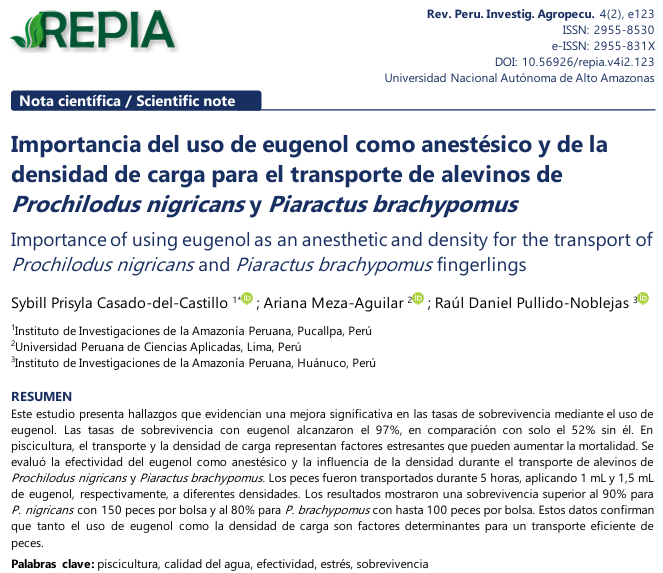Importance of using eugenol as an anesthetic and density for the transport of Prochilodus nigricans and Piaractus brachypomus fingerlings
DOI:
https://doi.org/10.56926/repia.v4i2.123Keywords:
fish farming, water quality, effectiveness, stress, survivalAbstract
This study presents evidence of a significant improvement in survival rates with eugenol use. Survival rates with eugenol reached 97%, compared with 52% without it. In aquaculture, transport and stocking density are recognized stressors that can increase mortality rates. The effectiveness of eugenol as an anesthetic and the impact of density during the transport of Prochilodus nigricans and Piaractus brachypomus fingerlings were evaluated. Fish were transported for 5 hours, with 1 mL and 1,5 mL of eugenol applied at varying densities. The results showed survival rates exceeding 90% for P. nigricans at 150 fish per bag and 80% for P. brachypomus at up to 100 fish per bag. These findings confirm that both eugenol use and appropriate stocking density are critical for efficient fish transport.
Downloads
References
Cunha, M. A., Zeppenfeld, C.C.; Oliveira, L.G.; Loro, V.L.; Braga, M.F.; Emanuelli, T.; Lima, A.P.; Copatti, C.E.; Baldisserotto, B. (2010). Anesthesia of silver catfish with eugenol: time of induction, cortisol response and sensory analysis of fillet. Ciência Rural, 40(10), 2107–2114. https://doi.org/10.1590/S0103-84782010005000154 DOI: https://doi.org/10.1590/S0103-84782010001000009
Gomes, L. C., Araujo-Lima, C. A. R. M., Chippai-Gomes, A. R., & Roubach, R. (2006). Transportation of juvenile tambaqui (Colossoma macropomum) in a closed system. Brazilian Journal of Biology, 66(2A), 493–502. https://doi.org/10.1590/S1519-69842006000300015 DOI: https://doi.org/10.1590/S1519-69842006000300015
Hoseini, S. M., Mirghaed, A. T., & Yousefi, M. (2018). Application of herbal anaesthetics in aquaculture. Reviews in Aquaculture, 11, 550–564. https://doi.org/10.1111/raq.12245 DOI: https://doi.org/10.1111/raq.12245
Omeji, S., Apochi, J. O., & Egwumah, K. A. (2017). Stress concept in transportation of live fishes – A review. Journal of Research in Forestry, Wildlife and Environment, 9(2), 56–64.
Ross, L. G., & Ross, B. (2008). Anaesthetic and sedative techniques for aquatic animals. Wiley-Blackwell. https://doi.org/10.1002/9781444302264 DOI: https://doi.org/10.1002/9781444302264
Souza, C. de F., Baldissera, M. D., Baldisserotto, B., Heinzmann, B. M., Martos-Sitcha, J. A., & Mancera, J. M. (2019). Essential oils as stress-reducing agents for fish aquaculture: A review. Frontiers in Physiology, 10, 785. https://doi.org/10.3389/fphys.2019.00785 DOI: https://doi.org/10.3389/fphys.2019.00785
Wang, J., Xu, K., Chen, X., Wang, H., & Li, Z. (2024). Effects of transport stress (duration and density) on the physiological conditions of marbled rockfish (Sebastiscus marmoratus, Cuvier 1829) juveniles and water quality. Fishes, 9(12), 474. https://doi.org/10.3390/fishes9120474 DOI: https://doi.org/10.3390/fishes9120474
Xu, J.-h., Liu, Y., Zhou, X.-w., Ding, H.-t., Dong, X.-j., Qu, L.-t., … Cheng, H.-l. (2021). Anaesthetic effects of eugenol on preservation and transportation of yellow catfish (Pelteobagrus fulvidraco). Aquaculture Research, 52(8), 3796–3803. https://doi.org/10.1111/are.15225 DOI: https://doi.org/10.1111/are.15225

Downloads
Published
How to Cite
Issue
Section
License
Copyright (c) 2025 Sybill Prisyla Casado-del-Castillo, Ariana Meza-Aguilar, Raúl Daniel Pullido-Noblejas

This work is licensed under a Creative Commons Attribution 4.0 International License.
Authors retain their rights:
a. The authors retain the intellectual property rights (copyright) of the published works, assigning to the journal the right of first publication.
b. Authors retain their trademark and patent rights, and also on any process or procedure described in the article.
c. Authors retain the right to share, copy, distribute, perform and publicly communicate the article published in REPIA (e.g., place it in an institutional repository or publish it in a book), with an acknowledgement of its initial publication in REPIA.
d. Authors retain the right to make a subsequent publication of their work, to use the article or any part of it (e.g., a compilation of their work, notes for conferences, theses, or for a book), provided they indicate the source of publication (authors of the work, journal, volume, number, and date).







